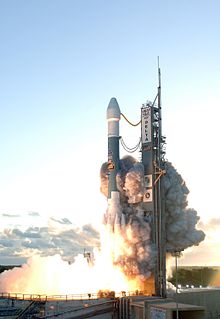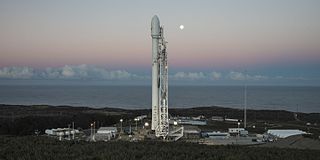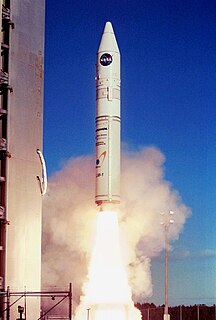
Cape Canaveral Air Force Station (CCAFS) is an installation of the United States Air Force Space Command's 45th Space Wing.

Delta II was an expendable launch system, originally designed and built by McDonnell Douglas. Delta II was part of the Delta rocket family and entered service in 1989. Delta II vehicles included the Delta 6000, and the two later Delta 7000 variants. The rocket flew its final mission ICESat-2 on 15 September 2018, earning the launch vehicle a streak of 100 successful missions in a row, with the last failure being GPS IIR-1 in 1997.

Delta is an American versatile family of expendable launch systems that has provided space launch capability in the United States since 1960. More than 300 Delta rockets have been launched with a 95% success rate. Only the Delta IV Heavy rocket remains in use as of August 22, 2019. Delta rockets are currently manufactured and launched by the United Launch Alliance.

Delta IV is a group of five expendable launch systems in the Delta rocket family introduced in the early 2000s. Originally designed by Boeing's Defense, Space & Security division for the Evolved Expendable Launch Vehicle (EELV) program, the Delta IV became a United Launch Alliance (ULA) product in 2006. The Delta IV was and is primarily a launch vehicle for United States Air Force military payloads, but has also been used to launch a number of U.S. government non-military payloads and a single commercial satellite.

The Thor-Able was an American expendable launch system and sounding rocket used for a series of re-entry vehicle tests and satellite launches between 1958 and 1960. It was a two stage rocket, consisting of a Thor IRBM as a first stage and a Vanguard-derived Able second stage. On some flights, an Altair solid rocket motor was added as a third stage. It was a member of the Thor family and an early predecessor of the Delta.

Space Launch Complex 3 (SLC-3) is a launch site at Vandenberg Air Force Base that consists of two separate launch pads. SLC-3E (East) is currently used by the Atlas V launch vehicle, while SLC-3W (West) has been demolished.

Space Launch Complex 6 at Vandenberg Air Force Base in California is a launch pad and support area. The site was originally developed for the Titan III and MOL, which was cancelled before construction of SLC-6 was complete. The complex was later rebuilt to serve as the west coast launch site for the Space Shuttle, but went unused due to budget, safety and political considerations. The pad was subsequently used for several Athena launches before being modified to support the Delta IV launch vehicle family, which have used the pad since 2006.

Cape Canaveral Air Force Station Space Launch Complex 37 (SLC-37), previously Launch Complex 37 (LC-37), is a launch complex on Cape Canaveral, Florida. Construction began in 1959 and the site was accepted by NASA to support the Saturn I program in 1963. The complex consists of two launch pads. LC-37A has never been used, but LC-37B launched uncrewed Saturn I flights and was modified and launched Saturn IB flights, including the first (uncrewed) test of the Apollo Lunar Module in space. It was deactivated in 1972. In 2001 it was modified as the launch site for Delta IV, a launch system operated by United Launch Alliance.

Cape Canaveral Air Force Station Space Launch Complex 41 (SLC-41), previously Launch Complex 41 (LC-41), is an active launch site at Cape Canaveral Air Force Station. The site is currently used by United Launch Alliance (ULA) for Atlas V launches. Previously, it had been used by the USAF for Titan III and Titan IV launches. The first launch of Vulcan is currently expected in April 2021.

Launch Complex 36 (LC-36)—formerly known as Space Launch Complex 36 (SLC-36) from 1997 to 2010—is a launch complex at Cape Canaveral Air Force Station in Brevard County, Florida. It was used for Atlas launches by NASA and the US Air Force from 1962 until 2005.

The Atlas-Agena was an American expendable launch system derived from the SM-65 Atlas missile. It was a member of the Atlas family of rockets, and was launched 109 times between 1960 and 1978. It was used to launch the first five Mariner uncrewed probes to the planets Venus and Mars, and the Ranger and Lunar Orbiter uncrewed probes to the Moon. The upper stage was also used as an uncrewed orbital target vehicle for the Gemini crewed spacecraft to practice rendezvous and docking. However, the launch vehicle family was originally developed for the Air Force and most of its launches were classified DoD payloads.

Cape Canaveral Air Force Station Space Launch Complex 40 (SLC-40), previously Launch Complex 40 (LC-40) is a launch pad for rockets located at the north end of Cape Canaveral, Florida.
Space Launch Complex 20 (SLC-20), previously designated Launch Complex 20 (LC-20), is a launch site at Cape Canaveral Air Force Station, Florida. SLC-20 is located at the northern terminus of ICBM Road, between Space Launch Complex 19 and Space Launch Complex 34.

Thor was a US space launch vehicle derived from the PGM-17 Thor intermediate-range ballistic missile. The Thor rocket was the first member of the Delta rocket family of space launch vehicles. The last launch of a direct derivative of the Thor missile occurred in 2018 as the first stage of the final Delta II.

The 45th Space Wing is a United States Air Force unit. It is assigned to the Fourteenth Air Force, stationed at Patrick Air Force Base, Florida. It commands Patrick AFB and the Cape Canaveral Air Force Station. The mission of the 45th Space Wing is to assure access to space and to support global operations.

Space Launch Complex 4 (SLC-4) is a launch and landing site at Vandenberg Air Force Base with two pads, both of which are used by SpaceX for Falcon 9 launch operations; operating as Landing Zone 4 (LZ-4) for SpaceX landings.

The Thor-Delta, also known as Delta DM-19 or just Delta was an early American expendable launch system used for 12 orbital launches in the early 1960s. A derivative of the Thor-Able, it was a member of the Thor family of rockets, and the first member of the Delta family.

The Spaceport Florida Launch Complex 46 (SLC-46) is a launch complex at Cape Canaveral Air Force Station operated under license by Space Florida for Athena rocket launches.

The Athena I, known as the Lockheed Launch Vehicle (LLV) at the time of its first flight and Lockheed Martin Launch Vehicle (LMLV) at the time of its second flight, is an American small expendable launch system which was used for four launches between 1995 and 2001. It is a member of the Athena family of rockets, along with the larger Athena II.





















